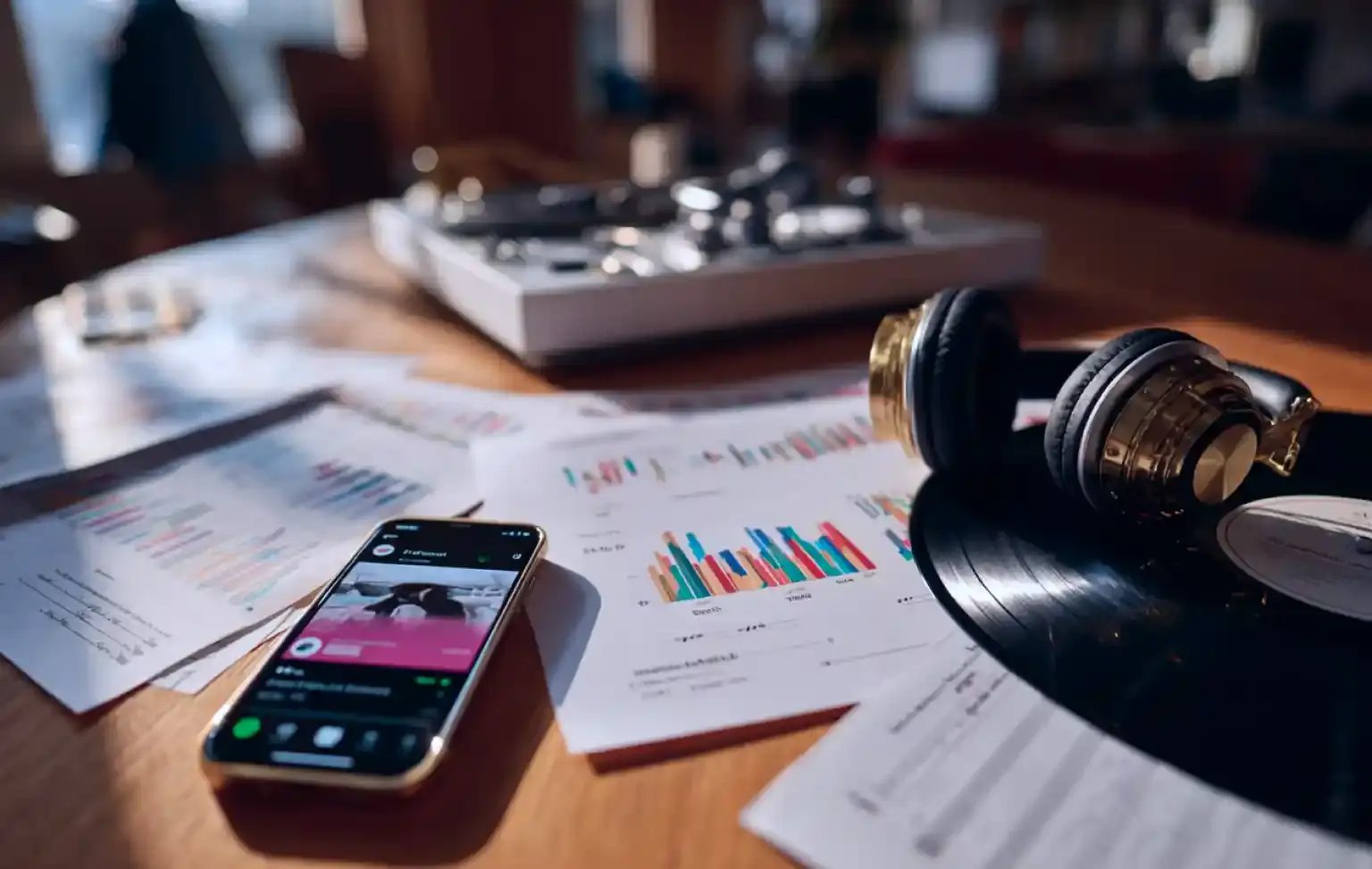Music royalties explained: What they are and why they matter to investors
ANote Music
July 29, 2025
6 min read

Music can be more than a form of entertainment, it can also be a source of passive income. Behind every stream, play on the radio, or soundtrack of a film lies a financial transaction: royalties.
Whether you're curious about diversifying your portfolio or just trying to understand the mechanics behind music investments, this article will walk you through how music royalties work, including a real-life example of how rights and royalties are distributed. You’ll learn who pays royalties, how they’re collected, and why they’ve become a growing point of interest for investors.
What are music royalties?
Music royalties are payments that a rights holder receives over time as compensation for the use of their copyrighted music. These rights holders can be singers, composers, authors, record labels, publishers, etc. In other words, royalties are paid when a song or composition is used, streamed, or distributed commercially.
How do music royalties work?
Think of the song as a pie: during its creation or production, agreements define how that pie will be split among the contributors: the singer, the label, composer, etc., When the song earns revenue — from streams, licensing, or public performance — royalties are collected and distributed to each party according to those agreements.
In recent years, some rights holders have chosen to sell a portion of their rights or the royalties interest related to those rights. For example, Bob Dylan or David Bowie, among other artists, sold their music catalogues in the past years. While this practice isn’t new, it was for a long time mainly reserved for large private funds or music industry insiders. Today, thanks to platforms that make these kinds of deals available to the public, rights holders can sell a portion of their royalty interests — meaning a share of their future royalties — also to smaller investors.
Rights holders decide whether to sell only the royalties interests or the full ownership of their rights. Here, it’s important to know that each song or composition has two types of copyrights:
- Publishing rights: related to the lyrics and melody of a song.
- Master rights: related to the specific recording, reproduction and distribution of the composition.
Each rights holder will own one of those rights (or both in some cases) and the type of royalties that they’ll receive will depend on the use of the song.
Let’s pick up the example of “In the name of love” by Martin Garrix ft Bebe Rexha. The following chart gives us a quick overview of the general parties involved, rights and royalties accordingly:
Steve James, American producer and DJ, sold a portion of the royalties he’d receive for his master rights on this song on ANote Music. This means that investors with an account on the platform, can buy shares of Steve James’s catalogue, which includes this song, and become entitled to earn part of the royalties that it will generate.
Who pays royalties and how are they collected?
Royalties are paid by anyone who uses music commercially — including streaming platforms, radio stations, TV broadcasters, film producers, live venues, shops and even restaurants. These businesses pay license fees to the rights holders directly or to the companies that represent them to play or broadcast their music to the public.
A familiar example may be the streaming platforms like Spotify, Apple Music, etc. People pay a subscription fee to listen to music on their phone, TV or at home. Part of these fees is periodically paid by the streaming platforms to the parties who own the rights of the songs that were played on the platforms. You can read more about how streaming platforms distribute royalties to music rights holders in our dedicated article.
The money flows through intermediaries called distributors, which are entitled to collect specific types of royalties for the rights holders. These companies can include national Collective Management Organisations (CMOs) such as SACEM (Société des Auteurs, Compositeurs et Éditeurs de Musique) or SIAE (Società Italiana degli Autori ed Editori), Performing Rights Organizations (PROs), record labels like Universal Music Group or Sony Music and/or publishers.
These organisations collect the royalties on behalf of the rights holders and periodically distribute them, according to the agreements in place.
Here are some common sources of royalty income:
- Master recording royalties: paid to the master rights holders whenever a song is streamed, sold in any format or downloaded.
- Mechanical royalties: paid to the publishing rights holders whenever a song is streamed, sold in any format or downloaded.
- Neighboring royalties: paid to the master rights holders whenever a song is played on the radio, concerts, or public venues.
- Performance royalties: paid to the publishing rights holders whenever a song is played on radio, concerts, or public venues.
- Sync license fee: paid for the right to use a specific recording or composition of a song in TV shows, ads, or movies.
Each type of royalty is connected to a specific kind of music rights. The more a song is used, the more royalties it can generate across these categories.
So, why are music royalties getting investor’s attention?
Even as economies shift, one thing stays constant: people keep listening to music. That means music royalties continue to generate income, especially in today’s streaming-driven world. While there are risks — as returns depend on the usage and performance of each catalogue — royalties from established music catalogues have historically shown more consistency than many traditional asset classes. They can offer an alternative source of passive income, often less affected by daily market swings.
Traditionally, investing in music royalties was limited to insiders and major financial institutions. But today, this asset class is more accessible than ever, thanks to platforms like ANote Music, which allow individual investors — regardless of industry knowledge - to participate, and for good reason.
Here’s why royalties are capturing investors attention:
1. Passive income stream
Music royalties are paid out periodically — similar to dividends. When you own shares in a music catalogue, you earn a portion of the royalties it generates.
2. Diversification
Music royalty income has historically shown low correlation with traditional financial markets. That means it could help smooth out portfolio volatility — especially useful during times of economic and geopolitical uncertainty.
3. Access to a fast-growing market
The global music industry is booming. Streaming, live concerts, and licensing continue to grow, pushing royalty revenues to new highs, becoming a promising source of passive income for new investors. In fact, Goldman Sachs projects the music industry will surpass $120 billion in revenues by 2030, with streaming playing a leading role.
4. Historical performance
While returns vary depending on catalogue performance, music royalties have historically offered competitive yields. Catalogues on ANote Music have generated average annual returns between 6% and 16%* over the past five years.
What does all of this tell us? Music royalties combine the relevance of music in our daily lives with the potential of financial opportunity. Whether it’s the steady stream of passive income, the long-term return potential, or the diversification benefits, royalties stand out as a compelling asset for modern investors.
* Disclaimer: Historical data does not guarantee future returns and should not be considered financial advice. Like all financial opportunities, music royalties carry risk. Catalogue performance can vary, and there are no guaranteed returns. Always review historical data and platform information carefully.











